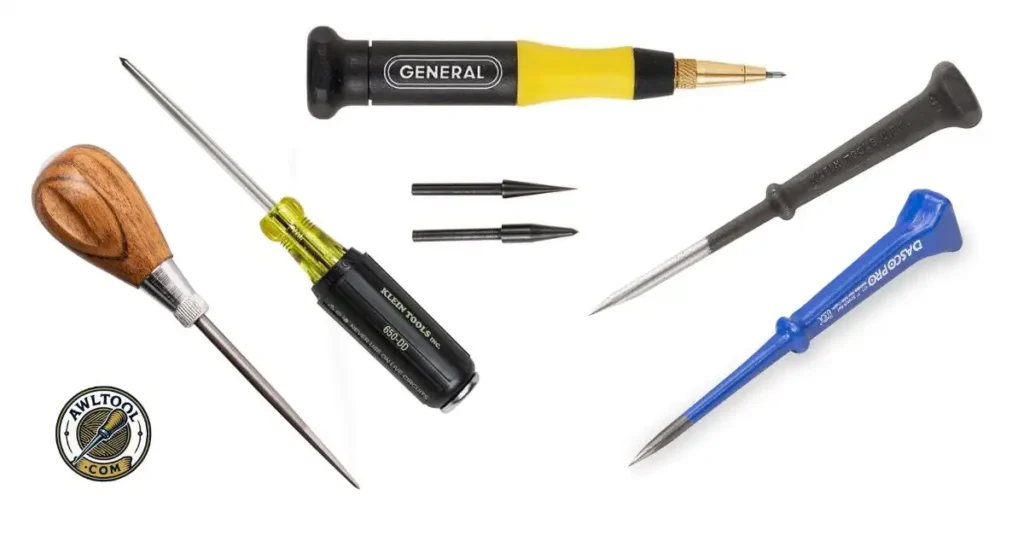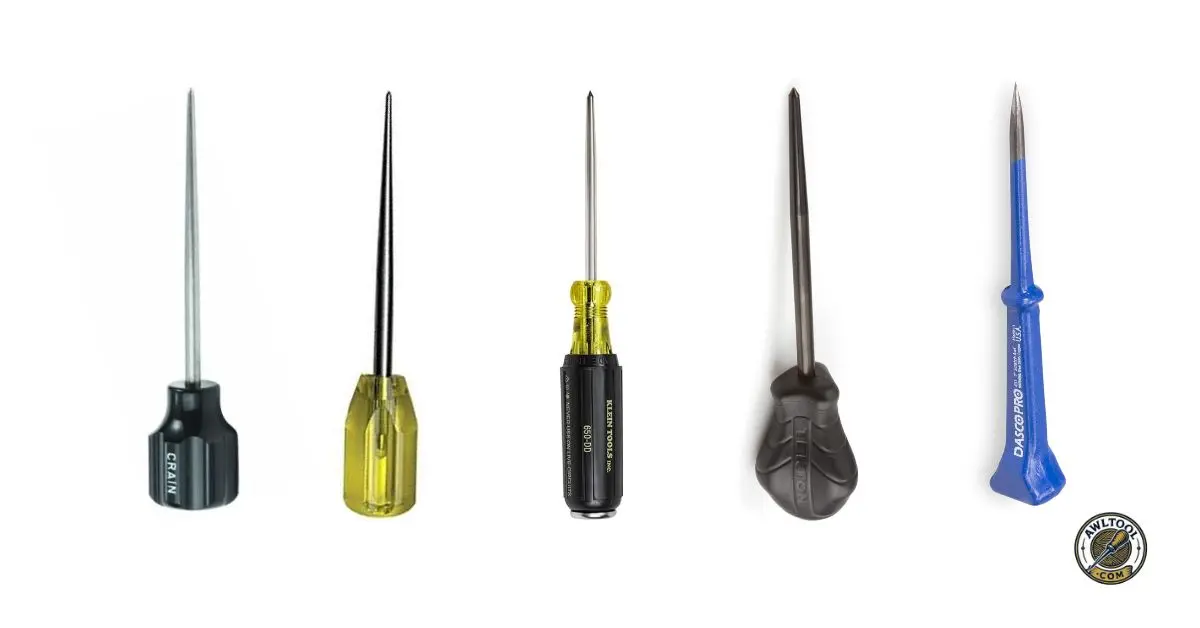Yes, there are many awl tools designed for specific crafting techniques. Each type of awl, whether for leatherworking, bookbinding, woodworking, shoemaking, or embroidery, has a unique tip shape, blade profile, and handle design. Using the correct awl improves accuracy, avoids damage, and gives a professional finish.
Check Out: Best Awl Tool In 2025
Table of Contents
Awls for Leatherworking
Check Out: 9 Best Awl Tool Sets for Leatherworking
Leatherworkers use a variety of awls depending on the task:
- Scratch awl: A sharp, fine-pointed awl for marking guidelines or scribing designs on leather surfaces.
- Stitching awl: Used to pierce holes for hand-stitching. Some models, like the Speedy Stitcher, hold a bobbin of thread to create lock-stitches.
- Diamond awl: Creates a diamond-shaped slit for strong, neat saddle stitches. Often paired with pricking irons.
- Curved awl: Ideal for stitching hard-to-reach or rounded leather parts, such as shoes or boxes.
- Blunt awl (creasing awl): Marks decorative lines or creases without piercing through the leather.
Awls for Bookbinding
Bookbinding requires precision awls that avoid tearing paper:
- Tapered awl: Blade widens near the handle, allowing control of hole size by varying depth.
- Bookbinder’s awl (straight needle awl): Creates uniform holes. Professionals use several sizes for different projects.
- Interchangeable needle awl: Has a chuck that holds different needles, letting one handle serve many purposes.
- Heavy-duty awl: Features a bulb-shaped handle for extra grip when piercing thick book board and covers.
Awls for Woodworking

Woodworkers use awls mainly for marking and starting holes:
- Scratch awl: Long, fine point for scribing precise layout lines on wood, metal, or plastic.
- Bradawl: Chisel-like tip that cuts a starting hole for screws or nails, preventing wood from splitting.
- Square awl: Square blade that bites into wood quickly, shearing fibers as it twists.
Awls for Shoemaking

Shoemakers use specialty awls for tight, heavy-duty stitching:
- Curved blade awl: Diamond-shaped curve for stitching welts and intricate shoe parts.
- Straight awl with hook: Lets shoemakers pull thread through while stitching straight seams.
- Inseaming awl: Spoon-shaped blade, often carbon steel, for piercing welts in leather shoes.
Awls for Embroidery and Sewing
Fine sewing and craft work need light, precise awls:
- Tailor’s awl: Slim, sharp tip used for marking buttonholes, feeding fabric into machines, or adjusting creases.
- Paper embroidery awl: For piercing single sheets of paper in cardmaking and scrapbooking. Built for accuracy, not force.
Why Specialized Awls Matter
Each awl is engineered for a specific material and motion:
- Leather awls cut slits without tearing.
- Bookbinding awls keep paper edges clean.
- Woodworking awls prevent cracks and guide screws.
- Shoemaking awls reach tight spots in thick leather.
- Sewing and embroidery awls give delicate control.
By choosing the right awl, you avoid damage, reduce mistakes, and get clean, professional results.
Where to Buy Awl Tools in the USA
Find these awls at Tandy Leather, Woodcraft, Joann, or online at Amazon and Weaver Leather. Many U.S. retailers sell starter sets that include several blade styles for hobbyists and professionals.
- 10 Best Awl Tool Shops in Idaho
- 10 Best Awl Tools Shops in Washington
- Top 6 Awl Tool Shops in New Mexico
FAQs About Awls for Crafting
Q: Are some awls only for leatherworkers?
Yes. Diamond, stitching, curved, and collar awls are specifically designed for leatherwork because they pierce thick hides cleanly and create holes shaped for tight, durable saddle stitches.
Q: Which awl works across multiple crafts?
A scratch awl is highly versatile for marking, scribing, or piercing light materials. The Speedy Stitcher also works on leather, canvas, and heavy fabrics, making it a good all-purpose tool for different projects.
Q: How do I maintain an awl?
Regularly sharpen the tip with fine sandpaper or a sharpening stone, wipe away debris, and oil any wooden handles to prevent cracking. Proper storage keeps the point from dulling or rusting.
Q: Can I switch tips on one awl handle?
Yes. Awl hafts with interchangeable needles let you change blade sizes or shapes for specific tasks, offering flexibility without buying multiple complete tools for different crafts.
Q: Are there different types of awls?
Yes, there are 18 types of awl tools, each designed for a specific craft like leatherworking, bookbinding, sewing, shoemaking, or woodworking, with different tip shapes, sizes, and functions.
Q: Do shoemakers use awls?
Absolutely. Shoemakers use inseaming awls, curved blade awls, and hooked awls to pierce and stitch thick leather in hard-to-reach areas like welts, soles, and curved shoe panels.
Q: What is a pattern awl?
A pattern awl is used to mark fabric or paper patterns with precise holes or points, guiding accurate cutting, stitching, or assembly without damaging the material.
Q: What can I use instead of an awl tool?
If you don’t have an awl, you can use an ice pick, sharp needle, thin nail, or small screwdriver as a temporary substitute, though these lack the precision of purpose-made awls.
Conclusion: Are There Awl Tools Designed for Specific Crafting Techniques?
Awls come in many types, each crafted for a specific job. Whether you work with leather, paper, wood, fabric, or shoes, the right awl improves accuracy and quality. For U.S. crafters, these tools are widely available and essential for professional results.
Related Article:
- How to Sharpen an Awl: 6 Step-by-Step Guide for Crafters
- Awl Tool Uses Guidelines & 7 Safety Tips
- What Is The Main Purpose Of An Awl? 10 Practical Uses
Join the Community on Instagram and Facebook: Share your favorite marking or drilling tools and tag us to get featured!



